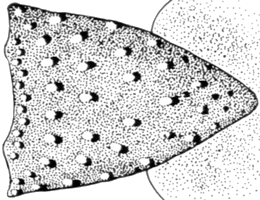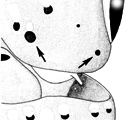- Photophores
- Compound photophores of uniform large size on anterior half of ventral mantle (a few minute photophores may be interspersed).
- Compound photophores number usually 16 (rarely 15) on right eyelid.
- Arms IV with 3 longitudinal series on arm base.
- Tips of arm I-III each with single, large, elongate, dark, simple, aboral photophore. Upper right drawing shows a side view and the lower drawing, an oral view.
- Each posteroventral margin of head with two conspicuous, large, round dark photophores widely spaced.
 Click on an image to view larger version & data in a new window
Click on an image to view larger version & data in a new window
Figure. Ventral view of mantle of H. macrohista, holotype. Drawing extracted from Fig. 36a of Voss (1969).
 Click on an image to view larger version & data in a new window
Click on an image to view larger version & data in a new window
Figure. Lateral view of right eyelid of H. macrohista, holotype. Drawing modified from Voss, 1969 (Fig. 36d).
 Click on an image to view larger version & data in a new window
Click on an image to view larger version & data in a new window
Figure. Ventral view of arm IV of H. macrohista, holotype. Drawing extracted from Fig. 36a of Voss (1969).
 Click on an image to view larger version & data in a new window
Click on an image to view larger version & data in a new window

Figure. Arm tips of H. macrohista. Left - Side view, paratype, 40 mm ML, male, Cook Strail, New Zealand. Drawing from Voss, 1969 (Fig. 37d). Right - Aboral view, holotype. Drawing from Voss, et al. (1998).
- Tentacles
- Suckers on manus in 6 irregular series; median suckers moderately enlarged (1.5-2 times ventral-marginal suckers). Rings of enlarged suckers with numerous sharp teeth around entire margin.
- Arms
- Length 80-130% of ML.
- Length 80-130% of ML.
- Arm suckers
- Inner rings with 4-10 low, rounded or square teeth on distal and lateral margins.
- Web and buccal crown
- Inner web large; length more than 50% of longest arm length; outer web slightly developed.
- Buccal crown with 7 supports.
- Funnel organ
- Heavy, swollen ridge on each lateral arm of dorsal pad.
- Fins
- Length 52-56% of ML; width 80-89% of ML.
- Length 52-56% of ML; width 80-89% of ML.
- Spermatophores
- Length 7-8% of ML; sperm mass 7-8% of spermatophore length (SpL); cement body 64-74% of SpL; ejaculatory apparatus 26-27% of SpL. Ejacualtory apparatus with single loop. Connective complex present.
- Length 7-8% of ML; sperm mass 7-8% of spermatophore length (SpL); cement body 64-74% of SpL; ejaculatory apparatus 26-27% of SpL. Ejacualtory apparatus with single loop. Connective complex present.
- Hectocotylus
- Both arms I in mature males modified in distal third. Suckers abruptly reduced in size, and on elongated palisaded pedestals.
Comments
The above description is from Voss (1969) and Voss, et al. (1998).









 Go to quick links
Go to quick search
Go to navigation for this section of the ToL site
Go to detailed links for the ToL site
Go to quick links
Go to quick search
Go to navigation for this section of the ToL site
Go to detailed links for the ToL site